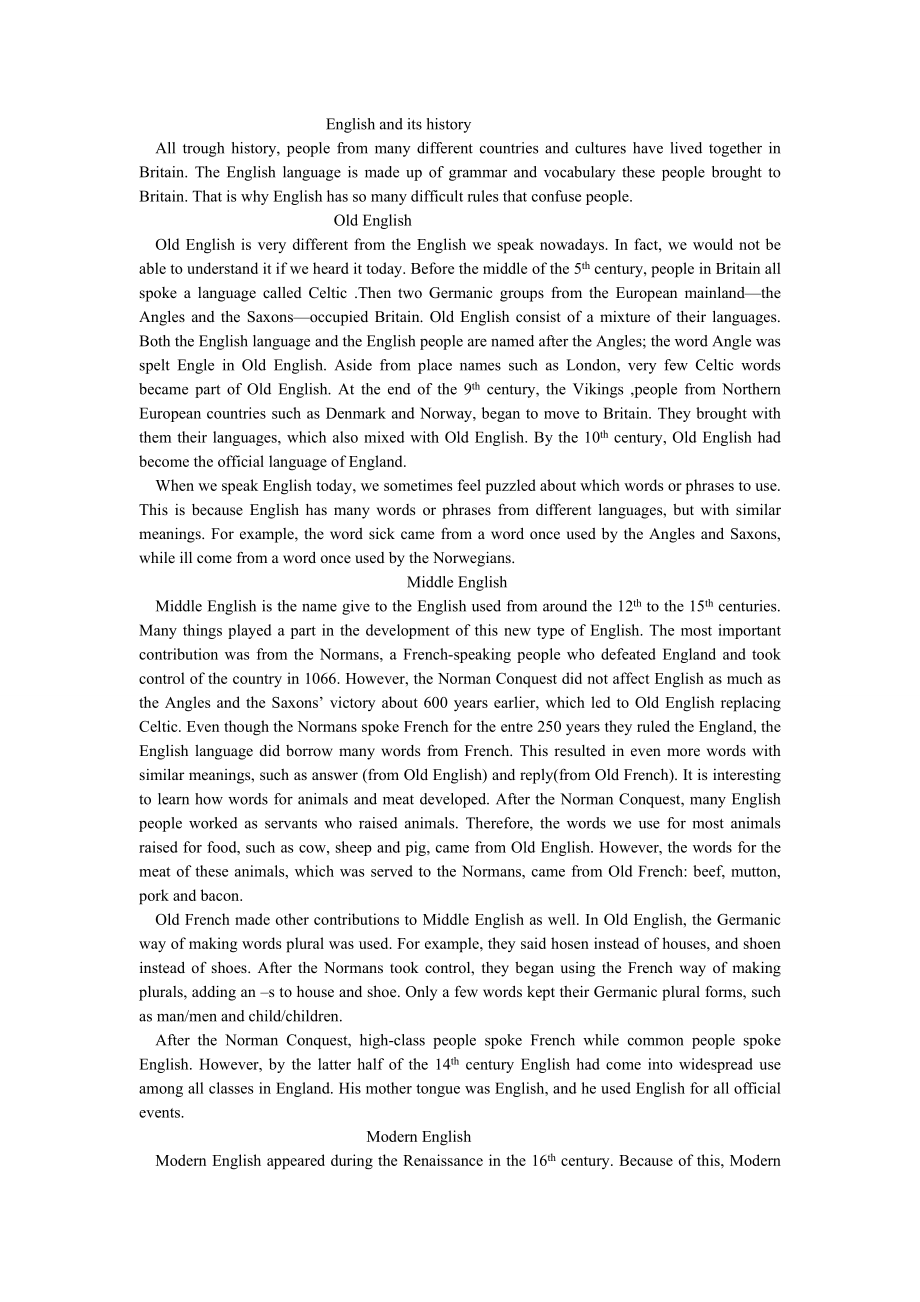 牛津高中英语模块3 unit2课文
牛津高中英语模块3 unit2课文


《牛津高中英语模块3 unit2课文》由会员分享,可在线阅读,更多相关《牛津高中英语模块3 unit2课文(2页珍藏版)》请在装配图网上搜索。
1、English and its history All trough history, people from many different countries and cultures have lived together in Britain. The English language is made up of grammar and vocabulary these people brought to Britain. That is why English has so many difficult rules that confuse people. Old English
2、 Old English is very different from the English we speak nowadays. In fact, we would not be able to understand it if we heard it today. Before the middle of the 5th century, people in Britain all spoke a language called Celtic .Then two Germanic groups from the European mainland—the Angles and the
3、Saxons—occupied Britain. Old English consist of a mixture of their languages. Both the English language and the English people are named after the Angles; the word Angle was spelt Engle in Old English. Aside from place names such as London, very few Celtic words became part of Old English. At the en
4、d of the 9th century, the Vikings ,people from Northern European countries such as Denmark and Norway, began to move to Britain. They brought with them their languages, which also mixed with Old English. By the 10th century, Old English had become the official language of England. When we speak Eng
5、lish today, we sometimes feel puzzled about which words or phrases to use. This is because English has many words or phrases from different languages, but with similar meanings. For example, the word sick came from a word once used by the Angles and Saxons, while ill come from a word once used by th
6、e Norwegians. Middle English Middle English is the name give to the English used from around the 12th to the 15th centuries. Many things played a part in the development of this new type of English. The most important contribution was from the Normans, a French-spe
7、aking people who defeated England and took control of the country in 1066. However, the Norman Conquest did not affect English as much as the Angles and the Saxons’ victory about 600 years earlier, which led to Old English replacing Celtic. Even though the Normans spoke French for the entre 250 year
8、s they ruled the England, the English language did borrow many words from French. This resulted in even more words with similar meanings, such as answer (from Old English) and reply(from Old French). It is interesting to learn how words for animals and meat developed. After the Norman Conquest, many
9、 English people worked as servants who raised animals. Therefore, the words we use for most animals raised for food, such as cow, sheep and pig, came from Old English. However, the words for the meat of these animals, which was served to the Normans, came from Old French: beef, mutton, pork and baco
10、n. Old French made other contributions to Middle English as well. In Old English, the Germanic way of making words plural was used. For example, they said hosen instead of houses, and shoen instead of shoes. After the Normans took control, they began using the French way of making plurals, adding a
11、n –s to house and shoe. Only a few words kept their Germanic plural forms, such as man/men and child/children. After the Norman Conquest, high-class people spoke French while common people spoke English. However, by the latter half of the 14th century English had come into widespread use among all
12、classes in England. His mother tongue was English, and he used English for all official events. Modern English Modern English appeared during the Renaissance in the 16th century. Because of this, Modern English includes many Latin and Greek words. Pronunciation also wen
13、t through huge changes during this period. Of course, this was not the end he changes in the English language. The question of weather English will keep on changing in the future is easy answer. It is certain that this process will continue, and people will keep inventing new words and new ways of saying things.
- 温馨提示:
1: 本站所有资源如无特殊说明,都需要本地电脑安装OFFICE2007和PDF阅读器。图纸软件为CAD,CAXA,PROE,UG,SolidWorks等.压缩文件请下载最新的WinRAR软件解压。
2: 本站的文档不包含任何第三方提供的附件图纸等,如果需要附件,请联系上传者。文件的所有权益归上传用户所有。
3.本站RAR压缩包中若带图纸,网页内容里面会有图纸预览,若没有图纸预览就没有图纸。
4. 未经权益所有人同意不得将文件中的内容挪作商业或盈利用途。
5. 装配图网仅提供信息存储空间,仅对用户上传内容的表现方式做保护处理,对用户上传分享的文档内容本身不做任何修改或编辑,并不能对任何下载内容负责。
6. 下载文件中如有侵权或不适当内容,请与我们联系,我们立即纠正。
7. 本站不保证下载资源的准确性、安全性和完整性, 同时也不承担用户因使用这些下载资源对自己和他人造成任何形式的伤害或损失。
